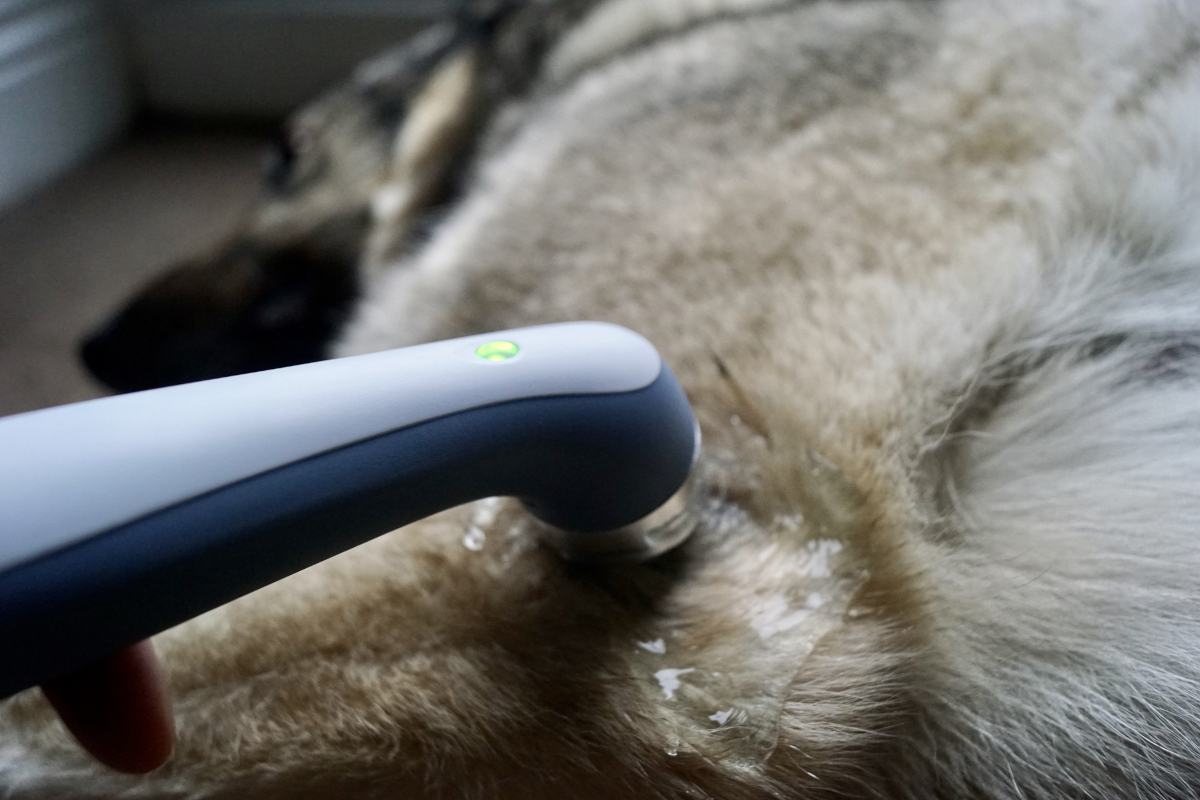THERAPEUTIC ULTRASOUND
—
Therapeutic ultrasound has become popular in veterinary practice and has proven interventions in a number of clinical problems. Ultrasound is a form of mechanical energy where mechanical vibration with increasing frequencies is known as sound energy. The normal human range of sounds is from 16 Hz to about 20,000 Hz. When this upper limit is exceeded, the mechanical vibration is known as ultrasound. The frequencies used in ultrasound therapy are usually in the range of 1.0 to 3.0 MHz.
THERAPEUTIC ULTRASOUND EFFECTS
All tissues will act as impedance for the passage of sound waves. However, from the point of view of clinical practice, the best absorbing tissues are those with high collagen content, such as ligament, tendon, fascia, joint capsule and scar tissue.
One of the therapeutic effects to which ultrasound has been applied is tissue healing. It is suggested that the application of ultrasound to damaged tissues, will accelerate the healing rate and improve the quality of repair. Therapeutic ultrasound has a thermal and non-thermal effect on the tissues.
In thermal effect, ultrasound will be most effective in heating the periosteum, collagenous tissues (ligament, tendon & fascia) & fibrotic muscle. If the temperature of the damaged tissues is raised to 40-45°C, then a hyperaemia will result, the effect of which will be therapeutic. In addition, temperatures in this range are also thought to help in initiating the resolution of chronic inflammatory states.
In non-thermal effect, ultrasound therapy is now attributed primarily to a combination of cavitation and acoustic streaming. Cavitation in the simplest sense refers to the formation of gas voids in tissues and body fluids and can be distinguished from stable and unstable. Each of them have a different effects on the tissues. Stable cavitation seems to occur with therapeutic doses of ultrasound. It is the formation and growth of gas bubbles by the accumulation of dissolved gas in the medium. The "cavity" strengthens the acoustic flow phenomenon and as such appears to be beneficial. Acoustic streaming is described as a small scale eddying of fluids near a vibrating structure such as cell membranes & the surface of stable cavitation gas bubble. This phenomenon is known to affect diffusion rates & membrane permeability. Sodium ion permeability is altered resulting in changes in the cell membrane potential. Calcium ion transport is modified which in turn leads to an alteration in the enzyme control mechanisms of various metabolic processes, especially concerning protein synthesis & cellular secretions. The result of the combined effects of stable cavitation and acoustic streaming is that the cell membrane becomes ‘excited’ (up regulates), thus increasing the activity levels of the whole cell. The ultrasound energy acts as a trigger for this process, but it is the increased cellular activity which is in effect responsible for the therapeutic benefits of the modality . Additionally, ultrasound therapy is accompanied by micro massage. This effect is a mechanical and causes molecules to vibrate, possibly enhancing tissue fluid interchange and affecting tissue mobility.

ULTRASOUND APPLICATION IN RELATION TO TISSUE REPAIR
To understand the therapeutic use of ultrasound, you must first understand the process of tissue healing. The process of tissue repair is a complex series of cascaded, chemically mediated events that lead to the production of scar tissue that constitutes an effective material to restore the continuity of the damaged tissue. The division into Bleeding, Inflammatory, Proliferative and Remodelling phases is almost arbitrary in that from a tissue perspective, this is in fact one continuous series of events, with a change in emphasis with time.
INFLAMMATION
During the inflammatory phase, ultrasound has a stimulating effect on the mast cells, platelets, white cells with phagocytic roles and the macrophages. For example, the application of ultrasound induces the degranulation of mast cells, causing the release of arachidonic acid which itself is a precursor for the synthesis of prostaglandins and leukotriene, which act as inflammatory mediators. By increasing the activity of these cells, the overall influence of therapeutic ultrasound is pro inflammatory. The benefit of this mode of action is to act as an ‘inflammatory optimiser’. The inflammatory response is essential to the effective repair of tissue, and the more efficiently the process can complete, the more effectively the tissue can progress to the next phase (proliferation). It is effective at promoting the normality of the inflammatory events, and as such has a therapeutic value in promoting the overall repair events. A further benefit is that the inflammatory chemically mediated events are associated with stimulation of the next (proliferative) phase, and hence the promotion of the inflammatory phase also acts as a promoter of the proliferative phase. The benefit of ultrasound is to make as efficient as possible to earliest repair phase, and thus have a promotional effect on the whole healing cascade. For tissues in which there is an inflammatory reaction, but in which there is no ‘repair’ to be achieved, the benefit of ultrasound is to promote the normal resolution of the inflammatory events, and hence resolve the ‘problem’ This will of course be most effectively achieved in the tissues that preferentially absorb ultrasound like the dense collagenous tissues.
PROLIFERATION
During the proliferative phase (scar production) ultrasound also has a stimulative effect (cellular up regulation), though the primary active targets are now the fibroblasts, endothelial cells and myofibroblasts. These are all cells that are normally active during scar production and US is therefore pro proliferative in the same way that it is pro inflammatory. It does not change the normal proliferative phase, but maximises its efficiency. Ultrasound increases protein synthesis, enhanced fibroplasia and collagen synthesis. Recent work has identified the critical role of numerous growth factors in relation to tissue repair, and some accumulating evidence has identified that therapeutic US has a positive role to play in this context and also with heat shock protein.
REMODELLING
During the remodelling phase of repair, the somewhat generic scar that is produced in the initial stages is refined such that it adopts functional characteristics of the tissue that it is repairing. A scar in ligament will not ‘become’ ligament, but will behave more like a ligamentous tissue. This is achieved by a number of processes, but mainly related to the orientation of the collagen fibres in the developing scar and also to the change in collagen type, from predominantly Type III collagen to a more dominant Type I collagen. The remodelling process is not a short duration phase. The application of therapeutic ultrasound can influence the remodelling of the scar tissue in that it appears to be capable of enhancing the appropriate orientation of the newly formed collagen fibres and also to the collagen profile change from mainly Type III to a more dominant Type I construction, thus increasing tensile strength and enhancing scar mobility. Ultrasound applied to tissues enhances the functional capacity of the scar tissues. The role of ultrasound in this phase may also have the capacity to influence collagen fibre orientation, though their conclusions were quite reasonably somewhat tentative. The application of ultrasound during the inflammatory, proliferative and repair phases is not of value because it changes the normal sequence of events, but because it has the capacity to stimulate or enhance these normal events and thus increase the efficiency of the repair phases. It would appear that if a tissue is repairing in a compromised or inhibited fashion, the application of therapeutic ultrasound at an appropriate dose will enhance this activity. If the tissue is healing ‘normally’, the application will, it would appear, speed the process and thus enable the tissue to reach its endpoint faster than would otherwise be the case.
SUMMARY OF MECHANISM OF ACTION
Good penetration while maintaining tissue selectivity
Increased in temperature, causes vasodilation and provides cellular energy
Increased cellular metabolism by providing cellular energy
Increased oxygen demand necessary for healing process
Allows inflammatory components to infiltrate the affected region
Mast cells become activated and degranulate
Triggers the arachidonic acid cascade developing a proinflammatory state
INDICATIONS OF THERAPEUTIC ULTRASOUND
Acute/Chronic Tendonitis
Superficial Digital Flexor Tendon, Deep Digital Flexor Tendon Injury/ Lesion
Suspensory Ligament Injury
Acute/ Chronic Muscle Strain, Fascial Pathology
Osteoarthritis
Scar Tissue/Adhesions/Wound Healing
Haematoma, Oedema
Trigger/ Stress Point
Soft Tissue Stretch
Nerve Injuries
Pain Management
Further details, and reference materials can be found at www.electrotherapy.org.
